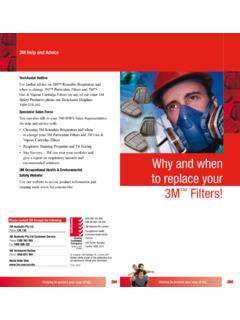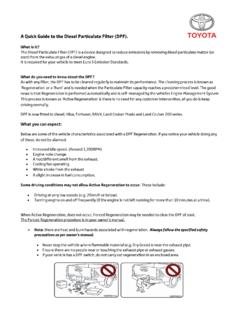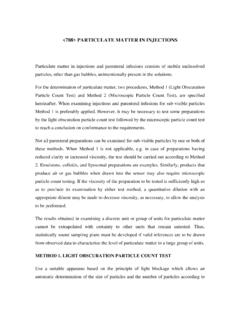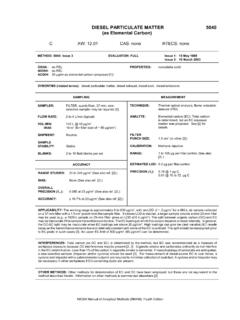Transcription of National Institute for Occupational Safety and Health
1 Uncontrolled Copy Uncontrolled Copy Uncontrolled Copy Uncontrolled Copy Uncontrolled Copy Uncontrolled Copy Uncontrolled Copy Uncontrolled Copy National Institute for Occupational Safety and Health National Personal Protective Technology Laboratory 626 Cochrans Mill Road Pittsburgh, PA 15236 Procedure No. TEB-APR-STP-0059 Revision: Date: 13 December 2019 DETERMINATION OF PARTICULATE filter EFFICIENCY LEVEL FOR N95 SERIES FILTERS AGAINST SOLID particulates FOR NON-POWERED, AIR-PURIFYING RESPIRATORS STANDARD TESTING PROCEDURE (STP) procedure establishes the means for ensuring that the particulate filtering efficiency of N95series filters used on non-p owered respirators submitted for Approval, Extension of Approval, orexamined during Certified Product Audits, meets the minimum certification standards set forth in42 CFR, Part 84, Subpart K, These filters or filter cartridges may be integral torespirator construction; mounted individually, or in sets of up to three.
2 Used in conjunction withcartridges and canisters for chin-style, front-mounted, and back-mounted gas masks; or used incombination with gas-and-vapor or atmosphere-supplying STP describes the test method to be used for the Determination of Particulate FilterEfficiency Level for N95 Series Filters Against Solid particulates for Non-Powered, Air-Purifying Respirators test in sufficient detail to allow a person knowledgeable in the appropriatetechnical field to conduct the test and determine whether or not the product meets the The list of necessary test equipment and materials TSI Model 8130 or 8130A Automated filter Tester or equivalent instrument - Air flow control accuracy is 2% of full scale. Pressure measurement accuracy is 2% of full scale. Penetrations can be measured to , efficiencies to Microbalance accurate to grams (g) Type A/E glass filters, 102 mm diameter, high efficiency filters with a 1 micron pore size Uncontrolled Copy Uncontrolled Copy Uncontrolled Copy Uncontrolled Copy Uncontrolled Copy Uncontrolled Copy Uncontrolled Copy Uncontrolled Copy Procedure No.
3 TEB-APR-STP-0059 Revision: Date: 13 December 2019 Page 2 of 9 Timer (accurate to percent) 2% sodium chloride solution in distilled water (NaCl) Temperature and humidity chamber capable of maintaining 38 C and 85 5% relative humidity Respirator filter holder supplied for specific manufacturer type which is compatible with TSI filter tester - NIOSH will not be obligated to use these holders for actual certification testing. All manufacturer test fixtures must be correlated with the NIOSH test method. Thermal printer (supplied), or optional data acquisition system TSI, Green Line Paper, part number 813010 - Lot number must be included on each box. Each lot must include the Penetration vs. Resistance graph . 4. TESTING REQUIREMENTS AND CONDITIONS Prior to beginning any testing, confirm that all measuring equipment employed has been calibrated in accordance with the testing laboratory s calibration procedure and schedule.
4 All measuring equipment utilized for this testing must have been calibrated using a method traceable to recognized international standards when available. Respirator filters and filter cartridges shall be tested as follows. The filtering elements of the respirator, including the filter holders and gaskets will be tested for particle penetration. When filters are not separable from the respirator body, the exhalation valves will be sealed to ensure that any leakage due to the exhalation valve is not included in the filter penetration measurement. Filters used in conjunction with gas mask canisters, and odd or unusually shaped filters may be tested on a headform assembly or test fixture provided by the applicant. If a test fixture is supplied by the applicant, the test fixture shall have a serial number or other unique, easily referenced identifier permanently etched, engraved, or affixed.
5 5. PROCEDURE Note: Where they have been developed to aid in the consistent operation of standard NIOSH test apparatus, work instructions are to be used. Respirator filters will be challenged by a NaCl aerosol at 25 5 C and a relative humidity of 30 10% that has been neutralized to the Boltzmann equilibrium state. The particle Uncontrolled Copy Uncontrolled Copy Uncontrolled Copy Uncontrolled Copy Uncontrolled Copy Uncontrolled Copy Uncontrolled Copy Uncontrolled Copy Procedure No. TEB-APR-STP-0059 Revision: Date: 13 December 2019 Page 3 of 9 size distribution will be a count median diameter of micrometer and a geometric standard deviation not exceeding Each respirator filter unit will be challenged with an aerosol concentration not exceeding 200 mg/m3.
6 The NaCl aerosol concentration will be determined on the days that initial penetration testing is performed by the following gravimetric method and calculated as milligrams per cubic meter (mg/m3). Weigh a 102 mm filter to the nearest mg., mount in the gravimetric filter holder, subject it to the generated aerosol at 30 Lpm for 40 minutes, then reweigh the filter . Use a timer to monitor the duration of the test. Record the pre- and post-weights, time, and average flow rate on the data sheet then calculate the aerosol concentration in mg/m3 by the following formula: Concentration in mg/m3 = W2 W1 (Q / 1000) (T) Where: W1 = Initial filter weight in mgs. W2 = Final filter weight in mgs. Q = Flowrate in liters per minute T = Elapsed time in minutes With a flowrate of 30 Lpm for 40 minutes, the above formula simplifies to: C = W2 W1 Use the following formula to calculate the test duration: T in minutes = (mg load) (1000 L / m3) (C) (Q) Where: C = Concentration in mg/m3 from Q = Flow rate for test in Lpm The upstream and downstream photometer readings are used for monitoring stability and for calculating a photometer correlation factor (CF).
7 The correlation factor is determined with an empty filter holder and is calculated internally as shown below: CF = Downstream Photometer Voltage Downstream Background Voltage Upstream Photometer Voltage Downstream Background Voltage The correlation factor is used by the software to express the upstream photometer signal in terms of the downstream photometer signal. The NaCl particle size distribution shall be verified using green line filter discs Uncontrolled Copy Uncontrolled Copy Uncontrolled Copy Uncontrolled Copy Uncontrolled Copy Uncontrolled Copy Uncontrolled Copy Uncontrolled Copy Procedure No. TEB-APR-STP-0059 Revision: Date: 13 December 2019 Page 4 of 9 supplied by TSI with a known penetration range. Graphs of penetration vs. resistance for two sheets and five sheets of stacked filter discs are supplied with each lot of the standard filters, with a central line and upper and lower lines representing the expected penetration range at a given resistance.
8 The test data should fall within an acceptance zone having boundaries defined by the upper and lower curves on the graphs. The standard filter test using both 2 sheets and 5 sheets will be run at least once in each 8 hour test period to verify that the aerosol distribution is within the acceptance zone. Respirator filters will be pre-conditioned at 85 5% relative humidity and 38 C for 25 1 hours. After conditioning, the filters shall be sealed in a gas tight container and tested within 10 hours. Filters will be mounted and sealed on holders to prevent leakage around the filter holder. Single air purifying respirator filters will be tested at a challenge flow rate of 85 4 Lpm. Filters used as pairs on a respirator are tested using a single filter of the pair at 2 Lpm challenge flow rate.
9 Filters used in threes are tested using a single filter of the set at 1 Lpm challenge flow rate. The challenge flow rate must be checked for stability for at least 30 seconds prior to testing. A sample of 20 filter units will be tested against the NaCl aerosol. Three filters will be loaded until the aerosol mass loading levels as shown in the table below are reached and evaluated to determine the method for the remaining 17 filters using one of the five type characterizations shown in , through The mass loading values in the table represent the mass of NaCl aerosol that has contacted the filter . Respirator filter Configuration (Inlet Airflow Split) Aerosol Mass Loading Level Single 200 5 mg. Double 100 5 mg. Triple 5 mg. Type 1. If preliminary testing of all three initial test filters consistently results in a straight line (Figure 3), for the remaining 17 filters, record the initial penetration reading.
10 Type 2. If filter testing of all three initial test filters consistently results in a curve which indicates increased efficiency during the complete run (Figure 3), for the remaining 17 filters, record the initial penetration reading. Type 3. If filter testing of all three initial test filters consistently results in decreased efficiency over time (Figure 3), load the remaining 17 filters with NaCl to the level specified in the table above and record the maximum penetration reading. Type 4. If filter testing of all three initial test filters consistently results in Uncontrolled Copy Uncontrolled Copy Uncontrolled Copy Uncontrolled Copy Uncontrolled Copy Uncontrolled Copy Uncontrolled Copy Uncontrolled Copy Procedure No. TEB-APR-STP-0059 Revision: Date: 13 December 2019 Page 5 of 9 increased efficiency, then a decrease in efficiency, and then flattens out during the remainder of the complete run (Figure 3 ), for the remaining 17 filters, record the maximum penetration reading after reaching and maintaining a flat line for a period of 20 minutes following the decreasing segment in efficiency.
















